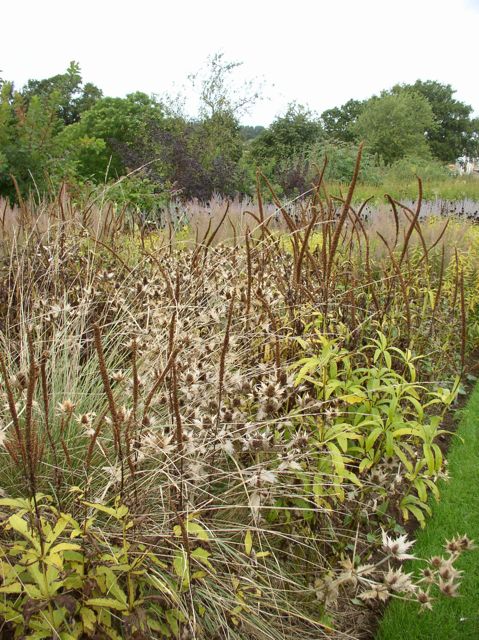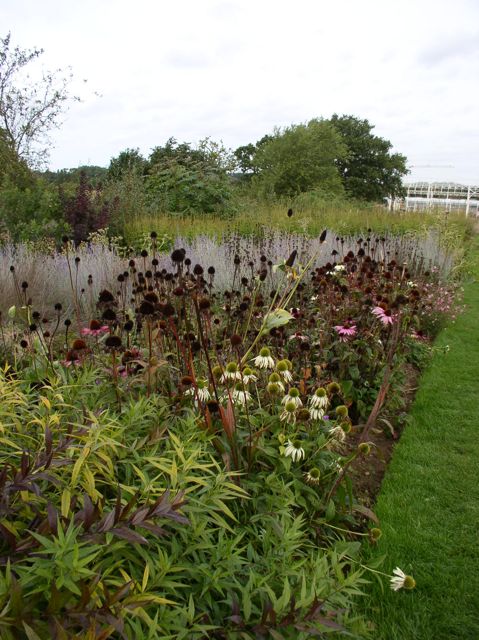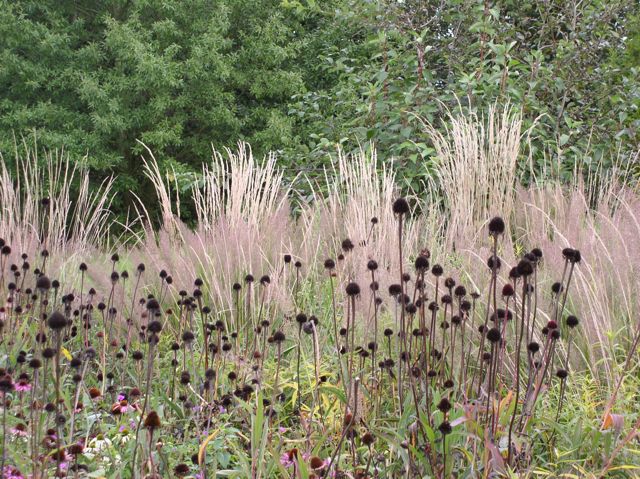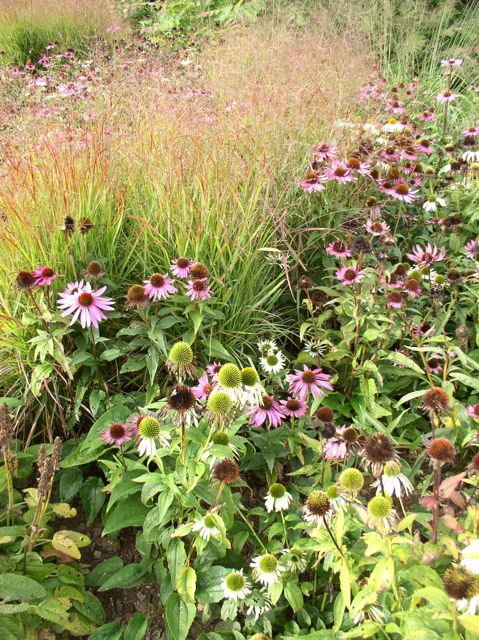
Once upon a time in the garden in winter, borders were put to bed, plants neatly clipped back to ground level and there was loads of bare shiney turned-over earth. A shrub or two, carefully chosen for seasonal merit, would break up the lovely monotony of the tilled soil. Nothing wrong with this at all except that it makes for a static scene that hangs on for the first of the spring bulbs to burst through the tilth and herald seasonal change. It also has to meet the reproach of being somewhat ungreen on the conservation front: if all your plants have been hacked back where can the ladybirds go?
For a different winter take, visit Wisley Gardens, HQ of the Royal Horticultural Society, and head for the far end of the grounds, to the Glasshouse Beds. Below the Fruit Mount are borders where sharp silhouettes and forms of plants take on the look of a musical score. There are a pair of vast matching beds, each over 11 metres wide and stretching the eye from a viewing mound down to the new glass house, a la Kew. These have had their planting designed by Piet Oudolf. (I asked a Dutchman how to pronounce it – Piet as in unfashionable use of peat and surname like someone falling over when saying ‘outdoors’).

So who is this man? He is Dutch, of course, and a veteran plantsman with his own nursery in the east of the Netherlands at Hummelo. He has developed and bred a strain of perennials that do not need high maintenance staking and tieing up. Perennials are herbaceous plants that die back into their rootstock to overwinter – what most of us call flowers. Oudolf plants them in enormous drifts, with flowering grasses romping through. The style is distinct and is now much copied as ‘New Perennial’ or ‘New Wave’. He is both designer and plant breeder – I read somewhere that he cycled round the country lanes, taking plants from the wayside and then cross breeding them to come up with strong sturdy offspring. His eye is very sure – the man originally trained as an architect – and the plants are put together in groups that tantalise and make you drool with the excellence of their harmony. Better still they prop each other up physically too.
These borders in late October reveal artistry: compelling to look at at a dog-day time of year. The recipe is simple - the choice of perennials with big seed heads and none have been chopped back yet so that fabulous blackened silhouettes pierce through a backdrop of flowing shimmering grasses.

Grasses have been done to death and sometimes get over-used as the 21
st century equivalent of the heather bed, that dull reminder of the 1960s. Forget the charge of cliché: grasses give the borders height, movement and interest amongst the strong verticals of the black and rust coloured flowerheads. Contrast and foil with the added bonus that many are cool season growers - they reach their apogee round about now.

The visitor, with an eye on edgy plant ideas for their own garden should go armed with a camera and a scrap of paper to scribble down plant associations to copy. Here are just a few pairs to inspire –
Echinacea purpurea ‘Rubinglow’, is a great plant with large daisy heads for late summer interest, the cones hang on to long stems and make a strong vertical statement seen in front of the fluffy white plumes of the grass
Calamagrostis brachytricha. At this time of the year
Astilbe chinensis ‘Purpurlanze’ leaves rust brown flower stalks which are perfect foil to the ghostly whitish bloom on the stems of
Perovskia atricifolia ‘Little Spire’. Make a note of what goes well with its neighbour. This is the real secret of good plant design and remember to think big – wide flowing streams or blocks of plants. Keep numbers of varieties down – less is definitely more.
 Once upon a time in the garden in winter, borders were put to bed, plants neatly clipped back to ground level and there was loads of bare shiney turned-over earth. A shrub or two, carefully chosen for seasonal merit, would break up the lovely monotony of the tilled soil. Nothing wrong with this at all except that it makes for a static scene that hangs on for the first of the spring bulbs to burst through the tilth and herald seasonal change. It also has to meet the reproach of being somewhat ungreen on the conservation front: if all your plants have been hacked back where can the ladybirds go?
For a different winter take, visit Wisley Gardens, HQ of the Royal Horticultural Society, and head for the far end of the grounds, to the Glasshouse Beds. Below the Fruit Mount are borders where sharp silhouettes and forms of plants take on the look of a musical score. There are a pair of vast matching beds, each over 11 metres wide and stretching the eye from a viewing mound down to the new glass house, a la Kew. These have had their planting designed by Piet Oudolf. (I asked a Dutchman how to pronounce it – Piet as in unfashionable use of peat and surname like someone falling over when saying ‘outdoors’).
Once upon a time in the garden in winter, borders were put to bed, plants neatly clipped back to ground level and there was loads of bare shiney turned-over earth. A shrub or two, carefully chosen for seasonal merit, would break up the lovely monotony of the tilled soil. Nothing wrong with this at all except that it makes for a static scene that hangs on for the first of the spring bulbs to burst through the tilth and herald seasonal change. It also has to meet the reproach of being somewhat ungreen on the conservation front: if all your plants have been hacked back where can the ladybirds go?
For a different winter take, visit Wisley Gardens, HQ of the Royal Horticultural Society, and head for the far end of the grounds, to the Glasshouse Beds. Below the Fruit Mount are borders where sharp silhouettes and forms of plants take on the look of a musical score. There are a pair of vast matching beds, each over 11 metres wide and stretching the eye from a viewing mound down to the new glass house, a la Kew. These have had their planting designed by Piet Oudolf. (I asked a Dutchman how to pronounce it – Piet as in unfashionable use of peat and surname like someone falling over when saying ‘outdoors’).
 So who is this man? He is Dutch, of course, and a veteran plantsman with his own nursery in the east of the Netherlands at Hummelo. He has developed and bred a strain of perennials that do not need high maintenance staking and tieing up. Perennials are herbaceous plants that die back into their rootstock to overwinter – what most of us call flowers. Oudolf plants them in enormous drifts, with flowering grasses romping through. The style is distinct and is now much copied as ‘New Perennial’ or ‘New Wave’. He is both designer and plant breeder – I read somewhere that he cycled round the country lanes, taking plants from the wayside and then cross breeding them to come up with strong sturdy offspring. His eye is very sure – the man originally trained as an architect – and the plants are put together in groups that tantalise and make you drool with the excellence of their harmony. Better still they prop each other up physically too.
These borders in late October reveal artistry: compelling to look at at a dog-day time of year. The recipe is simple - the choice of perennials with big seed heads and none have been chopped back yet so that fabulous blackened silhouettes pierce through a backdrop of flowing shimmering grasses.
So who is this man? He is Dutch, of course, and a veteran plantsman with his own nursery in the east of the Netherlands at Hummelo. He has developed and bred a strain of perennials that do not need high maintenance staking and tieing up. Perennials are herbaceous plants that die back into their rootstock to overwinter – what most of us call flowers. Oudolf plants them in enormous drifts, with flowering grasses romping through. The style is distinct and is now much copied as ‘New Perennial’ or ‘New Wave’. He is both designer and plant breeder – I read somewhere that he cycled round the country lanes, taking plants from the wayside and then cross breeding them to come up with strong sturdy offspring. His eye is very sure – the man originally trained as an architect – and the plants are put together in groups that tantalise and make you drool with the excellence of their harmony. Better still they prop each other up physically too.
These borders in late October reveal artistry: compelling to look at at a dog-day time of year. The recipe is simple - the choice of perennials with big seed heads and none have been chopped back yet so that fabulous blackened silhouettes pierce through a backdrop of flowing shimmering grasses.
 Grasses have been done to death and sometimes get over-used as the 21st century equivalent of the heather bed, that dull reminder of the 1960s. Forget the charge of cliché: grasses give the borders height, movement and interest amongst the strong verticals of the black and rust coloured flowerheads. Contrast and foil with the added bonus that many are cool season growers - they reach their apogee round about now.
Grasses have been done to death and sometimes get over-used as the 21st century equivalent of the heather bed, that dull reminder of the 1960s. Forget the charge of cliché: grasses give the borders height, movement and interest amongst the strong verticals of the black and rust coloured flowerheads. Contrast and foil with the added bonus that many are cool season growers - they reach their apogee round about now.
 The visitor, with an eye on edgy plant ideas for their own garden should go armed with a camera and a scrap of paper to scribble down plant associations to copy. Here are just a few pairs to inspire – Echinacea purpurea ‘Rubinglow’, is a great plant with large daisy heads for late summer interest, the cones hang on to long stems and make a strong vertical statement seen in front of the fluffy white plumes of the grass Calamagrostis brachytricha. At this time of the year Astilbe chinensis ‘Purpurlanze’ leaves rust brown flower stalks which are perfect foil to the ghostly whitish bloom on the stems of Perovskia atricifolia ‘Little Spire’. Make a note of what goes well with its neighbour. This is the real secret of good plant design and remember to think big – wide flowing streams or blocks of plants. Keep numbers of varieties down – less is definitely more.
The visitor, with an eye on edgy plant ideas for their own garden should go armed with a camera and a scrap of paper to scribble down plant associations to copy. Here are just a few pairs to inspire – Echinacea purpurea ‘Rubinglow’, is a great plant with large daisy heads for late summer interest, the cones hang on to long stems and make a strong vertical statement seen in front of the fluffy white plumes of the grass Calamagrostis brachytricha. At this time of the year Astilbe chinensis ‘Purpurlanze’ leaves rust brown flower stalks which are perfect foil to the ghostly whitish bloom on the stems of Perovskia atricifolia ‘Little Spire’. Make a note of what goes well with its neighbour. This is the real secret of good plant design and remember to think big – wide flowing streams or blocks of plants. Keep numbers of varieties down – less is definitely more. 